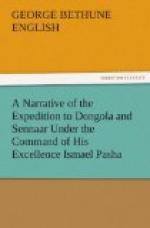[Footnote 65: The mountains of Bokki border upon the kingdom of Fezoueli, which lies south of Sennaar twenty days march. The mountains of Fezoueli are supposed to contain gold mines; pieces of gold are frequently found in the torrents that flow from those mountains in the rainy season. A native of that country told the Pasha Ismael, that he had seen a piece of gold, found in those mountains, as big as the bottom part of the silver narguil of his Excellence, i.e. about six inches in diameter. That there is gold in that country, is certain, as the female prisoners, taken at Bokki, had many gold rings and bracelets, of which they were quickly disencumbered by our soldiers. The Pasha intends to visit Fezoueli after the rainy season is over, to find the veins from whence this gold is washed down by the torrents, and, in case of success, to work the mines.]
[Footnote 66: We passed Attar Baal the same night. The reader is aware that a boat carrying a courier, could not be detained to give a passenger an opportunity to see ruins.]
[Footnote 67: The “Adit,” or Nile of Bruce, enters the Bahar el Abiud nearly at right angles, but such is the mass of the latter river, that the Nile cannot mingle its waters with those of the Bahar el Abiud for many miles below their junction. The waters of the Adit are almost black during the season of its augmentation; those of the Bahar el Abiud, on the contrary, are white: so that for several miles below their junction, the eastern part of the river is black, and the western is white. This white color of the Bahar el Abiud is occasioned by a very fine white clay with which its waters are impregnated. At the point of junction between the Bahar el Abiud and the Adit, the Bahar el Abiud is almost barred across by an island and a reef of rocks; this barrier checks its current, otherwise it would probably almost arrest the current of the Adit. It is, nevertheless, sufficiently strong to prevent the Adit from mingling with it immediately, although the current of the Adit is very strong, and enters the Bahar el Abiud nearly at right angles.]
[Footnote 68: Since my return to Egypt, we have learned that this army, after some bloody battles, had succeeded in taking possession of Darfour and Kordofan.]
[Footnote 69: The provinces lying on the third Cataract, between Shageia and Berber, are called, 1st, Monasier; 2d, Isyout, 3d, El Raba Tab.]
[Footnote 70: He came up in one of the nine boats that were able to pass, as mentioned before.]
[Footnote 71: As the people of these countries dislike the piasters of Egypt, I bought a quantity of soap at Sennaar from the Greeks who accompanied the army as sutlers, in order to serve as a medium of exchange; for in most of the provinces on the Upper Nile, they prefer soap to any thing you can offer, except dollars, or the gold coin of Constantinople.]
[Footnote 72: Khalil Aga, a native of New York, took the turban a few weeks before the departure of Ismael Pasha from Cairo. Learning that I was to accompany his Excellence, he requested me to obtain of the Pasha that he might be attached to me during the expedition. He is probably the first individual that ever traversed the whole of the river Nile from Rosetti to Sennaar. I have done the same, except about two hundred miles of the third cataract.]




